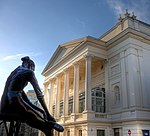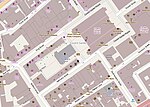Bow Street

Bow Street is a thoroughfare in Covent Garden, Westminster, London. It connects Long Acre, Russell Street and Wellington Street, and is part of a route from St Giles to Waterloo Bridge. The street was developed in 1633 by Francis Russell, 4th Earl of Bedford for residential purposes. A number of notable people lived here in the 17th and 18th centuries, including Oliver Cromwell and Robert Harley, 1st Earl of Oxford. In the 18th century, the street declined as a place of residence following the establishment of the nearby Covent Garden Theatre, which led to a reputation for prostitution. During the 19th century, Bow Street was a de facto extension of Covent Garden and its associated markets, selling then-exotic fruit and vegetables.Bow Street has a strong connection with the law; the Bow Street Runners, an early voluntary police force, was established here by Henry Fielding in 1750, and the Metropolitan Police Service operated a station house from 1832, which led to the construction of the Bow Street Magistrates' Court. Today, only a short run of buildings from No. 35 to Russell Street remain on their original sites; the rest having been given up for large buildings.
Excerpt from the Wikipedia article Bow Street (License: CC BY-SA 3.0, Authors, Images).Bow Street
Bow Street, London Covent Garden
Geographical coordinates (GPS) Address Nearby Places Show on map
Geographical coordinates (GPS)
| Latitude | Longitude |
|---|---|
| N 51.513055555556 ° | E -0.12194444444444 ° |
Address
Royal Opera House
Bow Street
WC2E 9DD London, Covent Garden
England, United Kingdom
Open on Google Maps









